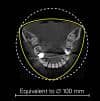with Robert Chastant, DDS

Chastant: In 1993, I started video imaging. At that time, Louisiana did not have an organized means to provide for proper identification of our state’s children. At that time, I worked with [several] companies to develop a bare-bones database program to gather images and fingerprints electronically. From there, I met with our local parish school board, where I proposed a free service to the community and school system that would entail identifying children. The school board was very receptive to the idea, and the basic concept was born. It’s a really simple and effective procedure. There is a volunteer mother that organizes and runs the program. She coordinates with the local sheriff, who provides a deputy to participate at the schools. We go to every school in our district and ID every second-grader. Over the years, the relationship with the community has grown astronomically. I have now provided identification screenings to more than 15,000 children.
In subsequent years, I have spoken to other orthodontists about the program at industry events. Everyone who heard about it thought it was a great idea, which led me to another great idea: Why not expand the program nationwide using local orthodontists as the conduit to conduct the child-screening program? This marked the point that the program began to adapt to a nationwide model. One of the first challenges was to develop a scalable procedure for gathering and storing the data that would make it as user-friendly and efficient as possible.
And it is obvious how worthwhile this endeavor can be if you just look at the statistics. Fewer than 20% of all children in our nation have any kind of identification records on file; and of this 20%, most of the ID kits have been lost or are inadequate to get information to authorities in a timely fashion. Nearly 1 million children go missing in the United States annually.
To date, my research indicates that there is no other organized program to gather appropriate data on all children. I feel proud that we are working to provide proper identification of all our nation’s children. The AAO is the perfect vehicle to bring this to the United States. We have a true interest in the well-being of children and the funds to provide this service.
OP: What information will be taken?
Chastant: We have written a program that allows participating orthodontists to go to schools and gather information, photos, and fingerprints electronically. DNA swabs will be taken and mailed to our central location for storage. All information is bar-coded for security, and the laptops are branded and secure to provide for storage on the Web-based national server. The kit will come with a coded laptop, digital camera, bar-code scanner, fingerprint scanner, photo backdrop, carrying case, first year’s swabs, and instructions. We want to make the start of the program easy for the orthodontists who participate.
OP: How will orthodontists benefit?
Chastant: We must emphasize that the program has been developed solely to protect our nation’s greatest asset: our children. It does come with intrinsic values to the orthodontic practice, though. Each sponsoring orthodontist will be provided with an exclusive opportunity to provide screenings within the school districts that he or she serves. It will cost less than a direct-mail piece, but the community goodwill gained will more than outweigh the associated practice benefits. The parents will receive a CD with the information on their child, presented by the participating orthodontist. Birthday cards can be sent out recommending updated photos, and many more contacts with the student can be provided.
OP: How will having this information on file be helpful to the child?
Chastant: The DNA and other data will be uploaded and stored in a repository in Louisiana near the Acadiana Crime Lab. We envision the information being available to the locating agencies, such as Amber Alert and the local police, electronically. Therefore, the photos and—more importantly—the fingerprints will be available in just minutes. We are working with law-enforcement agencies to provide a fingerprint-compatibility standard that will work with the image standards already in place with other fingerprint systems to allow cross-matching and positive identification in just minutes. We anticipate that police cars will have photos on the laptops in their cars as soon as the police release the missing persons file. If the fingerprint is not considered the final evidence, then our DNA can be retrieved and cross-matched in less than 24 hours. To ensure good DNA samples that mom cannot lose, our samples will be stored under the security of bar-code scanning that can be retrieved quickly. Locating the child quickly is the answer.
Robert Chastant, DDS, is in private practice in New Iberia, La. He can be reached at (337) 367-1271 or [email protected].










